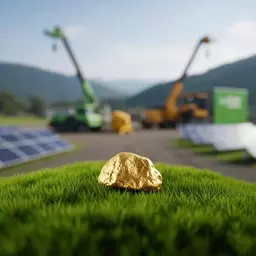Core Principle 1Sustainable Practices & Goals
- Protecting Biodiversity
- Reducing Carbon Footprint
- Water Conservation
Join Madeline Harper's community for exclusive updates on Australian gold mining trends, exploration, and investment opportunities.
Posted on: 2025-10-25
By: Madeline Harper
As we navigate the complexities of gold mining, understanding the balance between resource extraction and environmental stewardship is crucial. How can the industry adapt to meet sustainability goals while maintaining profitability? Here are the key insights that will help you grasp the future of responsible mining practices.
The Australian gold mining industry is increasingly focusing on environmental stewardship. The following visual highlights the core areas driving this sustainable transformation. For a deeper dive into market trends, explore Australian Gold Mining Market Insights.
As someone deeply immersed in the gold mining industry, I can’t stress enough the importance of environmental stewardship. It's not just a buzzword—it's a vital practice that shapes the future of mining in Australia. With the increasing scrutiny on environmental impacts, sustainable mining practices are not only beneficial for our planet but also essential for long-term profitability and community trust.
In my experience, companies that prioritize sustainability tend to outperform their peers, both in financial metrics and public perception. By adopting responsible practices, mining companies can mitigate risks associated with environmental degradation, ultimately fostering a healthier ecosystem for future generations.
Sustainable mining practices are fundamental to balancing resource extraction and environmental preservation. They ensure that we can continue to benefit from gold mining while minimizing ecological footprints. Here are some key aspects:
These practices are becoming increasingly critical as global demand for gold persists. Companies that embrace sustainability will not only improve their operational efficiency but also enhance their reputations among investors and stakeholders. For more information on how technology is revolutionizing the industry, see our article on Tech Innovations in Gold Mining.
At Gold Mining Insights, our mission aligns with embracing sustainable practices. Environmental stewardship goals encompass various facets of mining operations:
These goals are not merely regulatory requirements; they reflect a broader commitment to corporate responsibility and ethical mining. By working towards these aims, we can ensure that gold mining remains a sustainable venture that benefits both the economy and the environment.
Corporate Social Responsibility (CSR) in the gold mining sector is about taking accountability for the impact of our operations on the environment and society. This includes:
As we adopt CSR principles, we not only contribute positively to society but also build trust and loyalty among stakeholders. Mining companies that integrate CSR into their core mission are more likely to achieve long-term success and sustainability in the gold mining industry.
As a stakeholder in the gold mining industry, what sustainability initiatives do you think are most critical for the future? Share your thoughts below:
As we look towards the future of gold mining in Australia, the emphasis on sustainability is more crucial than ever. The industry is witnessing a significant shift towards environmental stewardship, driven by both regulatory pressures and a growing societal demand for responsible practices. This transformation isn't just about compliance; it's about redefining how we view mining within the broader context of environmental and social responsibility.
Among the most exciting emerging trends in environmental stewardship are the integration of innovative technologies and collaborative frameworks that support sustainable mining. As someone who has spent over a decade in this industry, I have seen firsthand how these advancements not only enhance operational efficiency but also align with our collective responsibility to protect the planet.
Several key trends are shaping the future of environmental stewardship in Australian gold mining. These include:
These trends not only reflect a commitment to sustainability but also present unique investment opportunities in a rapidly changing marketplace. As we embrace these innovations, the potential for a more sustainable gold mining sector becomes increasingly evident. For a detailed look at how specific regions are advancing, consider Sustainable Gold Mining in Western Australia.
Industry bodies play a pivotal role in promoting sustainable practices within the mining sector. They set standards, provide frameworks for compliance, and encourage the adoption of best practices among their members. Voluntary reporting mechanisms have emerged as a significant tool for companies to showcase their sustainability efforts.
By actively participating in these initiatives, mining companies can not only improve their public image but also attract conscientious investors who prioritize environmental and social governance (ESG) factors.
In the face of climate change, it is imperative for the mining industry to develop robust adaptation strategies. This involves assessing risks and implementing proactive measures to mitigate potential impacts. Through my research, I've found that successful strategies often include:
These strategies not only safeguard operations but also contribute to the broader effort of combating climate change, ensuring that future generations can benefit from Australia’s rich mineral resources.
Here is a quick recap of the important points discussed in the article:
Environmental stewardship in gold mining refers to the responsible management of environmental impacts associated with mining operations. This includes protecting biodiversity, reducing carbon footprints, conserving water, and adopting sustainable practices to ensure long-term ecological health while maintaining profitability.
Sustainable mining practices are crucial for balancing resource extraction with environmental preservation. They help minimize ecological footprints, reduce operational costs through resource efficiency, and foster positive relationships with local communities, leading to long-term profitability and enhanced public perception for mining companies.
CSR in gold mining involves taking accountability for the social and environmental impacts of operations. Key aspects include engaging with local communities, maintaining transparency, and investing in local development projects. This builds trust, fosters loyalty among stakeholders, and contributes to the company's long-term success and sustainability.
Emerging trends include increased use of renewable energy sources (solar, wind), adoption of circular economy principles (recycling, waste minimization), enhanced stakeholder engagement, and investment in eco-friendly technologies like advanced water recycling and sustainable extraction methods.
The mining sector is adapting to climate change by implementing robust strategies suchs as risk assessment frameworks to identify vulnerabilities, investing in resilient infrastructure to withstand extreme weather, and utilizing data analytics to monitor climate trends and adjust operations proactively.



 As we gear up for the investment opportunities of 2025, understanding the dynamics of the Australian
As we gear up for the investment opportunities of 2025, understanding the dynamics of the Australian
 In an era where technology meets tradition, the gold mining industry is at the forefront of innovati
In an era where technology meets tradition, the gold mining industry is at the forefront of innovati
 What does the future of gold mining look like, and how can we ensure it is sustainable? As the indus
What does the future of gold mining look like, and how can we ensure it is sustainable? As the indus